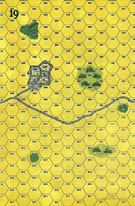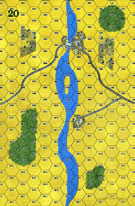| Author |
PaperTiger
|
| Method |
Solo |
| Victor |
Soviet Union |
| Play Date |
2012-06-08 |
| Language |
English |
| Scenario |
RtBr067
|
The Soviets began the action with cavalry units in the larger town on Map 18, with three units of armor in the single hex village. The town on Map 20 which included the bridge was defended to the gills: HMG, INF, and two 76's. The smaller town to the south held mortars and another 76. Reserve units were held in the town on Map 19.
The Soviet strategy was simple: stand pat on the bridge. When the action began, the forward cavalry units would fan out, avoiding contact with the enemy. Instead they would range the field, spotting for the artillery and picking off the stragglers and demoralized.
Before I set up for the German attack, I had to ask myself: who would go for the bridge? Would it be the seasoned soldiers of the Army or the throw together units of the SS? Since ultimate German leadership clung to the idea of German supermen, I gave that "honor" to the SS. The army units would enter north of the road and slug its way east. The SS would enter on the road and follow the way cleared by the army before going after the bridge.
But first came the matter of the Soviet armor. With the mission of keeping the Soviet tanks busy, the panzers rolled up the road.
Unfortunately, the method of keeping the Soviet tanks busy was to provide them with target practice. Between apallingly bad rolls by the Germans and apallingly good ones by the Soviets, the panzers were soon done for. A Soviet tank platoon kept the road bottled up while the other two swung left and began to do its work on the SS.
Meanwhile the Soviet cavalry did its job. The slow advance of the Germans was further hampered by the OBA and on board fire called down on them by an enemy that would not engage.
When the German army units were about to break into the open on the east side of the NW woods on Map18, the Soviet tanks had already swung back and set up a wall of steel between the woods and the field. Meanwhile Soviet INF reinforced in the field. At the same time Soviet cavalry kept calling down artillery on the hapless SS and picking off their stragglers.
With onky an hour to go, the Germans were still nowhere near their goals. Even if they had been, they were in no shape to take on the Soviet defenses at the bridge. Soviet armor and cavalry roamed west of the canal with near-impunity. Continuing would only lead to additional slaughter. I called the action and gave it to the Soviets.
A special commendation in this action goes to the German OBA. Their little popguns laid down barrages that consistantly hit their mark, resulting in enemy diruptions and demoralizations.
|






 RtBr066
RtBr066 



































